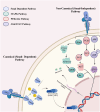TGF-β: elusive target in diabetic kidney disease
- PMID: 40180324
- PMCID: PMC11980245
- DOI: 10.1080/0886022X.2025.2483990
TGF-β: elusive target in diabetic kidney disease
Abstract
Transforming growth factor-beta (TGF-β), a cytokine with near omnipresence, is an integral part of many vital cellular processes across the human body. The family includes three isoforms: Transforming growth factor-beta 1, 2, and 3. These cytokines play a significant role in the fibrosis cascade. Diabetic kidney disease (DKD), a major complication of diabetes, is increasing in prevalence daily, and the classical diagnosis of diabetes is based on the presence of albuminuria. The occurrence of nonalbuminuric DKD has provided new insight into the pathogenesis of this disease. The emphasis on multifactorial pathways involved in developing DKD has highlighted some markers associated with tissue fibrosis. In diabetic nephropathy, TGF-β is significantly involved in its pathology. Its presence in serum and urine means that it could be a diagnostic tool while its regulation provides potential therapeutic targets. Completely blocking TGF-β signaling could reach untargeted regions and cause unanticipated effects. This paper reviews the basic details of TGF-β as a cytokine, its role in DKD, and updates on research carried out to validate its candidacy.
Keywords: Cytokine; diabetic kidney disease; fibrosis; transforming growth factor-beta.
Conflict of interest statement
No potential conflict of interest was reported by the author(s).
Figures
Similar articles
-
Renal fibrosis as a hallmark of diabetic kidney disease: potential role of targeting transforming growth factor-beta (TGF-β) and related molecules.Expert Opin Ther Targets. 2022 Aug;26(8):721-738. doi: 10.1080/14728222.2022.2133698. Epub 2022 Oct 18. Expert Opin Ther Targets. 2022. PMID: 36217308
-
How to inhibit transforming growth factor beta safely in diabetic kidney disease.Curr Opin Nephrol Hypertens. 2021 Jan;30(1):115-122. doi: 10.1097/MNH.0000000000000663. Curr Opin Nephrol Hypertens. 2021. PMID: 33229911 Review.
-
The key role of the transforming growth factor-beta system in the pathogenesis of diabetic nephropathy.Ren Fail. 2001 May-Jul;23(3-4):471-81. doi: 10.1081/jdi-100104730. Ren Fail. 2001. PMID: 11499562 Review.
-
TGF-beta in diabetic kidney disease: role of novel signaling pathways.Cytokine Growth Factor Rev. 2000 Mar-Jun;11(1-2):115-23. doi: 10.1016/s1359-6101(99)00035-0. Cytokine Growth Factor Rev. 2000. PMID: 10708959 Review.
-
Transforming growth factor-beta2 antibody attenuates fibrosis in the experimental diabetic rat kidney.J Endocrinol. 2001 Sep;170(3):647-51. doi: 10.1677/joe.0.1700647. J Endocrinol. 2001. PMID: 11524245
Cited by
-
Small Interfering RNA (siRNA) for Cardiorenal Disease: Mechanistic Insights from Preclinical and Clinical Studies.J Cardiovasc Transl Res. 2025 Jun 25. doi: 10.1007/s12265-025-10649-4. Online ahead of print. J Cardiovasc Transl Res. 2025. PMID: 40560279 Review.
References
-
- Ong KL, Stafford LK, McLaughlin SA, et al. . Global, regional, and national burden of diabetes from 1990 to 2021, with projections of prevalence to 2050: a systematic analysis for the Global Burden of Disease Study 2021. The Lancet. 2023;402(10397):203–234. doi: 10.1016/S0140-6736(23)01301-6. - DOI - PMC - PubMed
Publication types
MeSH terms
Substances
LinkOut - more resources
Full Text Sources
Medical



